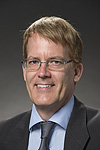ELBNF is born
 |
|
Joe Lykken
|
At approximately 6:15 p.m. CST on Jan. 22, 2015, the largest and most ambitious experimental collaboration for neutrino science was born.
It was inspired by a confluence of scientific mysteries and technological advances, engendered by the P5 report and the European Strategy update, and midwifed by firm tugs from Fermilab, CERN and Brookhaven Lab. Going by the placeholder name ELBNF (Experiment at the Long Baseline Neutrino Facility), the newborn had the impressive heft of 145 institutions from 23 countries.
The new Institutional Board (IB), convened by interim chair Sergio Bertolucci, unanimously approved a Memorandum of Collaboration that launches the election of spokespeople and a process to develop bylaws. The IB also endorsed an international governance plan for oversight of ELBNF detector projects, in concert with the construction of the LBNF facility hosted by Fermilab.
The goal of this international collaboration is crystal clear: a 40-kiloton modular liquid-argon detector deep underground at the Sanford Underground Research Facility exposed to a megawatt-class neutrino beam from Fermilab with the first 10 kilotons in place by 2021. This goal will enable a comprehensive investigation of neutrino oscillations that can establish the presence of CP violation for leptons, unequivocally determine the neutrino mass ordering and strongly test our current neutrino paradigm. A high-resolution near detector on the Fermilab site will have its own rich physics program, and the underground far detector will open exciting windows on nucleon decay, atmospheric neutrinos and neutrino bursts from supernova detonations.
Unlike most births, this one took place at an international meeting hosted by Fermilab; there was room for nearly all the friends and family of accelerator-based neutrino experiments. One of the critical items flagged at this meeting is to find a better name for the new collaboration. Here are a few of my unsolicited attempts:
nuLAND = neutrino Liquid ArgoN Detector
GOLDEN = Giant OsciLlation Detector Experiment for Neutrinos
Think you can do better? Go ahead. My older son, a high-priced management consultant, offered another one pro bono: NEutrino Research DetectorS.
I am too young to have been in the room when ATLAS and CMS (or for that matter CDF and DZero) came into being, but last week I had the thrill of being part of something that had the solid vibe of history being made. The meeting website is here.
|